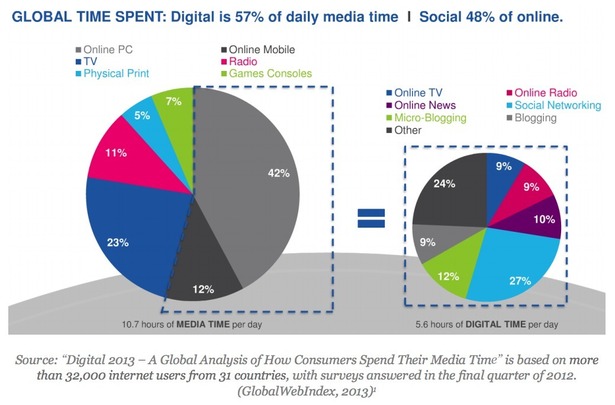It covers how to define the convergent environment, identifies pain points in managing new workflows and examines how the measurement of media is evolving as a result.
The author identified four key trends running through the report. These are …
1. The consumer is in the driving seat
The ever growing number of media channels and customer touch points has caused a shift in the way that brands communicate with consumers.
Consumers now have more control than ever in regard to how and when they engage with different media channels,
This creates a complex analytical landscape and agencies need to be up to the task of demonstrating not just the optimal mix but how they can be agile enough to keep up with consumer demands.
2. Digital domination
Discussions surrounding media convergence are dominated by digital channels, due to both the range of channels and the ability to deliver data at an extremely granular level.
In fact digital now accounts for more than half of daily media time.

This means that clients are required to work with agencies and technology providers to manage that data effectively, allow data sharing between offline and online channels, and ensure that it is used to deliver appropriate campaigns to the right consumer at the right time.
3. Reassessing the client/supplier relationship
The increasingly complex media landscape means that clients are looking to their suppliers to help them to navigate a constantly changing environment.
While this has created a golden opportunity for agencies to lead the way in industry knowledge and expertise, it also gives rise to new challenges. The report shows that more than half (54%) of agencies believe that media convergence has had a ‘very significant’ impact on their business.
How would you describe the impact that media convergence has had on your agency?

The challenge for suppliers is two-fold: to keep ahead of the field by innovating and, secondly, to communicate that expertise to clients in a business-relevant way.
4. Making measurement fit for purpose
Convergence is delivering greater transparency in both data and analytics, meaning that campaign effectiveness is more measurable than ever before.
This means that client-side marketers are becoming much more commercially-driven, so suppliers must adapt to new KPIs and take the lead in ensuring channel measurement truly reflects consumer engagement with brands instead of focusing on purely operational metrics.

Comments